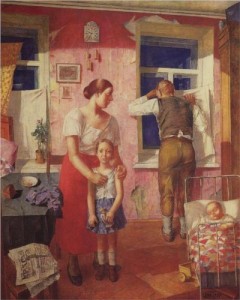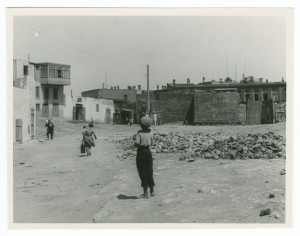For much of the twentieth century, the United States and the Soviet Union were superpowers engaged in a struggle against one another in which children were held up as symbols of each state’s successes and failures. Aspects of my comparative approach could be applied to a Cold War course or unit, a World Since 1945 survey, or even an Advanced Placement European, World or U.S. History setting.
Ideas
To introduce students—perhaps in a historical methods context—to the history of childhood, direct them to read and discuss the following underpinnings of the field:
- Philippe Aries, “Education and the Concept of Childhood,” in Childhood in America, pp. 283-285.
- Claudia Castaneda, Introduction to Figurations: Child, Bodies, Worlds (2002)
- Stephanie Coontz, “In Search of a Golden Age”
- Hugh Cunningham, “Histories of Childhood,” The American Historical Review 103:4 (October 1998): 1195-1208.
- Paula Fass and Mary Ann Mason, Introduction to Childhood in America (2000), pp. 1-7.
- Mary Jo Maynes, “Age as a Category of Historical Analysis: History, Agency, and Narratives of Childhood,” Journal of the History of Childhood and Youth 1:1 (2008): 114-124.
- Steven Mintz, Huck’s Raft, Preface
- Steven Mintz, “Reflections on Age as a Category of Historical Analysis,” Journal of the History of Childhood and Youth 1,1 (2008): 91-94.
- Steven Mintz, “Why The History of Childhood Matters,” Journal of the History of Childhood and Youth 5:1 (Winter 2012): 15-28.
- Leslie Paris, “Through the Looking Glass: Age, Stages, and Historical Analysis,” Journal of the History of Childhood and Youth 1,1 (2008): 106-113.
- Larry Wolff, “Then I Imagine a Child: The Idea of Childhood and the Philosophy of Memory in the Enlightenment,” Eighteenth-Century Studies 31:4: 377-401
A military history unit could integrate child soldier memoirs or scholarly studies of children and war. Here, I recommend the following:
- Children and War: A Historical Anthology. Edited by James Marten. New York: NYU Press, 2002.
Employ these two readings in dialogue with each other to get students thinking about how children in the U.S.S.R. and U.S.A. endured World War II:
- Lisa Kirschenbaum, “Innocent Victims and Heroic Defenders: Children and the Siege of Leningrad”, Children and War, pp. 279-290.
- Robert William Kirk, “American Children in the Second World War,” in Childhood in America, pp. 269-271.
Prepare film studies with the following reading:
- Alexander Prokhorov, “Arresting Development: A Brief History of Soviet Cinema for Children and Adolescents, in Russian Children’s Literature and Culture, pp. 129-148.
In reconstructing children’s experiences, historians tap a wide range of sources. Share images of childhood in the Soviet Union with your students. Frank Whitson Fetter’s photographs of daily life in the Soviet provinces represent an untapped resource to scholars working on a variety of topics, including Russian visual culture, the history of Soviet childhood and everyday life, as well as Russian-American cultural relations in the twentieth-century.
A student interested in researching the history of public health could be directed to Child Health History on the Web
Have a unit about émigré experiences? Inject children and youth into the discussions. Consider utilizing Jessica Clark, “Treasured Memories: Growing Up German-Russian on the Northern Plains,” The Journal of the History of Childhood and Youth, 5:2 (Spring 2012): 260-238.
Introduce students to school settings and the diversity of experiences in Russia and the U.S.S.R. through these sources:
- E. Thomas Ewing, “Ethnicity at School: Educating the ‘Non-Russian’ Children of the Soviet Union, 1928-1939.” History of Education (UK) Vol. 35, No. 4-5 (July September 2006) pp. 499-519.
- Catriona Kelly, ‘The School Waltz’: The Everyday Life of the Post-Stalinist Soviet Classroom”
- The Library of Congress Prokudin-Gorskii Collection:
Consider pairing these two readings to get your students thinking and talking about childhood spaces, past and present:
- Rebecca Friedman, “Masculinity, the Body, and Coming of Age in the Nineteenth-Century Russian Cadet Corps,” The Journal of the History of Childhood and Youth, 5:2 (Spring 2012): 219-238.
- “Where Children Sleep”
If students are interested in children’s literature, direct them to this virtual exhibition: Children’s Books of the Early Soviet Era
Use the following to spark conversations about youth, generations and historical change or, alternately, the Cold War.
- Elena Glazov-Corrigan, “Moscow Childhood: The Make-Up of a Generation, 1991”
- Donald J. Raleigh, “Graduates of the Cold War,” or Donald J. Raleigh, Introduction to Russia’s Sputnik Generation: Soviet Baby Boomers Talk About Their Lives
- Selections from Juliane Fürst, Stalin’s Last Generation: Soviet Post-War Youth and the Emergence of Mature Socialism
RESOURCES
Books:
- E. Thomas Ewing, Separate Schools: Gender, Policy, and
- Practice in Postwar Soviet Education (2010)
- Paula Fass and Mary Ann Mason, Childhood in America
- Boris Gorshkov, Russia’s Factory Children, Society, and the State: Childhood, Apprenticeship and Law, 1800-1917
- Catriona Kelly, Children’s World: Growing Up in Russia, 1890-1991 (2007)
- Lisa Kirshenbaum, Small Comrades: Revolutionizing Childhood in Soviet Russia, 1917-1932
- Olga Kucherenko, Little Soldiers: How Soviet Children Went to War, 1941-45 (Oxford: Oxford University Press, 2011).
- Mary Jo Maynes, Birgitte Soland, and Christina Beninghaus, eds., Secret Gardens, Satanic Mills: Placing Girls in European History, 1750-1960
- Steven Mintz, Huck’s Raft: A History of American Childhood (2004)
- Jacqueline Olich, Competing Ideologies and Children’s Literature in Russia, 1918-1935
Journals:
Red Feather: An International Journal of Children’s Visual Culture
The Journal of the History of Childhood and Youth (JHCY) is a scholarly, peer-reviewed journal focused on the history of childhood and youth cultures and the experiences of young people across diverse times and places.
Websites:
Society for the History of Children and Youth (SHCY) serves as a hub for both interdisciplinary and multidisciplinary research
Children and Youth in History includes primary sources, case studies and teaching modules.
The Working Group on Russian Children’s Literature and Culture is a scholarly non-profit organization dedicated to fostering closer communication among scholars interested in Russian children’s literature, history of childhood, theater, cinema, popular media, education, and other aspects of children’s culture.
Listservs:
H-Childhood is an edited electronic network focused on the history of childhood and youth.
The Department of Childhood Studies at Rutgers-Camden’s Exploring_childhood_studies, an online mailing list which serves as a clearinghouse for the exchange of information, resources, and knowledge among academics and practitioners who work in the field of childhood studies.
Childhoods-net-l mailing list childhoods-net-l@uleth.ca

